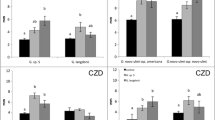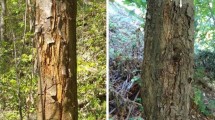Abstract
Dutch elm disease (DED) is not a three organism “elm-fungus-bark beetle” system, as originally believed. The DED fungus, Ophiostoma novo-ulmi, also often carries with it its own natural enemy, a type of virus known as a “d-factor.” These viruses are probably specific to the fungus. DED is therefore really an “elm-fungus-fungal virus-bark beetle” system. A virus can sometimes so severely debilitate the O. novo-ulmi fungus that it critically reduces its effectiveness as an elm pathogen, preventing it from entering the sapstream of elm trees via the feeding wounds of the elm bark beetles. Indeed in some situations, the viruses may exert a strong natural biological control over the O. novo-ulmi population. Their properties are therefore being studied under field conditions and in the laboratory with a view to their possible release either as natural or genetically modified biological control agents. Washington DC, Oregon, and New Zealand appear particularly favorable target areas for experimental release of natural viruses.
Access this chapter
Tax calculation will be finalised at checkout
Purchases are for personal use only
Preview
Unable to display preview. Download preview PDF.
Similar content being viewed by others
References
Abdelali E, Brasier CM, Bernier L. 1999. Localization of a pathogenicity gene in Ophiostoma novoulmi and evidence that it may be introgressed from O. ulmi. Molecular Plant-Microbe Interactions 12: 6–15.
Anagnostakis SL, Chen B, Geletka LM, Nuss DL. 1998. Hypovirus transmission to ascospore progeny by field-release transgenic hypovirulent strains of Cryphonectriaparasitica. Phytopathology 88: 598–604.
Brasier CM. 1983. A cytoplasmically transmitted disease of Ceratocystis ulmi. Nature 305:220–223.
Brasier CM. 1986a. The d-factor in Ceratocystis ulmi: its biological characteristics and implications for Dutch elm disease. Pages 177–208 in: Fungal Virology, KW Buck, ed. CRC Press, Boca Raton, Florida, USA.
Brasier CM. 1986b. The population biology of Dutch elm disease: its principal features and some implications for other host-pathogen systems. Pages 55–118 in: Advances in Plant Pathology, Volume 5, DS Ingram and, PH Williams, eds. Academic Press, London, UK.
Brasier CM. 1988. Rapid changes in genetic structure of epidemic populations of Ophiostoma ulmi. Nature 332: 538–541.
Brasier CM. 1996a. Low genetic diversity of the Ophiostoma novo-ulmi population in North America. Mycologia 86: 951–964.
Brasier CM. 1996b. New horizons in Dutch elm disease control. Pages 20–28 in: Report on Forest Research 1996. Forestry Commission. HMSO, London.
Brasier CM, Gadgil P. 1992. Dutch elm disease outbreak in New Zealand. Page 39 in: Report on Forest Research 1991. HMSO, London.
Brasier CM, Kirk SA, Pipe N, Buck KW. 1998. Rare hybrids in natural populations of the Dutch elm disease pathogens Ophiostoma ulmi and O. novo-ulmi. Mycological Research 102: 45–57.
Charter NW, Buck KW, Brasier CM. 1993. De novo generation of mitochondrial DNA plasmids following cytoplasmic transmission of a degenerative disease in Ophiostoma novo-ulmi. Current Genetics 24: 504–51
Choi GH, Nuss DL. 1992. Hypovirulence of chestnut blight fungus conferred by an infectious viral cDNA. Science 257: 800–803.
Cole TE, Müller BM, Hong Y, Brasier CM, Buck KW. 1998. Complexity of virus-like double-stranded RNA elements in a diseased isolate of the Dutch elm disease fungus, Ophiostoma novo-ulmi. Journal of Phytopathology 146: 593–598.
Hong Y, Cole TE, Brasier CM, Buck KW. 1998. Evolutionary relationships among putative RNA-dependent RNA polymovases encoded by a mitochondrial virus-like RNA in the Dutch elm disease fungus, Ophiostoma ulmi, by other viruses and virus-like RNAs, and by the Arabidopsis mitochondrial genome. Virology 246: 158–169.
Mitchell AG, Brasier CM. 1994. Contrasting structure of European and North American populations of Ophiostoma ulmi. Mycological Research 98: 576–582.
Rogers HJ, Buck KW, Brasier CM. 1986a. Transmission of double-stranded RNA and a disease factor in Ophiostoma ulmi. Plant Pathology 35: 277–28
Rogers HJ, Buck KW, Brasier CM. 1986b. The d2-factor in Ophiostoma ulmi: expression and latency. Pages 393–400 in: Biology and Molecular Biology of Plant-Pathogen Interactions, JA Bailey, ed. Springer Verlag, Berlin.
Rogers HJ, Buck KW, Brasier CM. 1987. A mitochondrial target for double-stranded RNA in diseased isolates of the fungus that causes Dutch elm disease. Nature 329: 558–560.
Rogers HJ, Buck KW, Brasier CM. 1988. DsRNA and disease factors of the aggressive subgroup of Ophiostoma ulmi. Pages 327–351 in: Viruses of Fungi and Simple Eukaryotes, Y Koltin, MJ Leibowitz, eds. Marcel Dekker, New York.
Sutherland ML, Brasier CM. 1995. Effect of d-factors on in-vitro cerato-ulmin production by the Dutch elm disease pathogen Ophiostoma novo-ulmi. Mycological Research 99: 1211–1217.
Sutherland ML, Brasier CM. 1997. A comparison of thirteen d-factors as potential biological control agents of Ophiostoma novo-ulmi. Plant Pathology 46: 680–693.
Webber JF. (1987). Influence of the d2 factor on survival and infection by the Dutch elm disease pathogen Ophiostoma ulmi. Plant Pathology 36: 531–538.
Webber JF. 1990. Relative effectiveness of Scolytus scolytus, S. multistriatus and S. kirschi as vectors of Dutch elm disease. European Journal of Forest Pathology20:184–192.
Webber JF. 1993. D-factors and their potential for controlling Dutch elm disease. Pages 322–332 in: Dutch Elm Disease Research: Cellular and Molecular Approaches, MB Sticklen, JL Sherald, eds. Springer-Verlag, New York.
Webber JF, Brasier CM. 1984. The transmission of Dutch elm disease: a study of the processes involved. Pages 271–306 in: Invertebrate-Microbial Interactions, JM Anderson, ADM Rayner, D Walton, eds. Cambridge University Press, Cambridge, UK.
Editor information
Editors and Affiliations
Rights and permissions
Copyright information
© 2000 Springer Science+Business Media New York
About this chapter
Cite this chapter
Brasier, C.M. (2000). Viruses as Biological Control Agents of the Dutch Elm Disease Fungus Ophiostoma novo-ulmi . In: Dunn, C.P. (eds) The Elms. Springer, Boston, MA. https://doi.org/10.1007/978-1-4615-4507-1_12
Download citation
DOI: https://doi.org/10.1007/978-1-4615-4507-1_12
Publisher Name: Springer, Boston, MA
Print ISBN: 978-1-4613-7032-1
Online ISBN: 978-1-4615-4507-1
eBook Packages: Springer Book Archive




